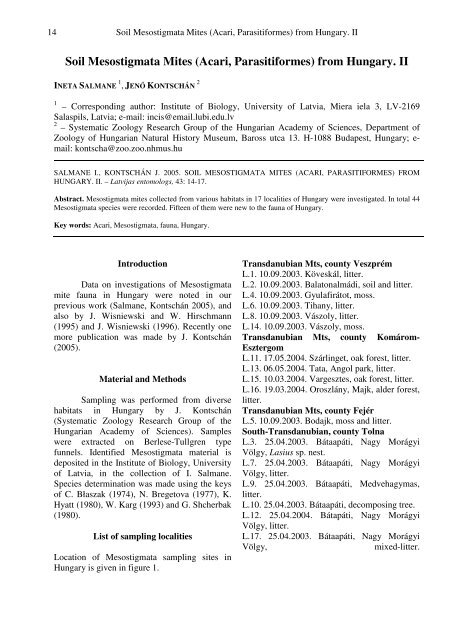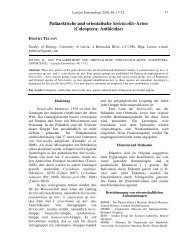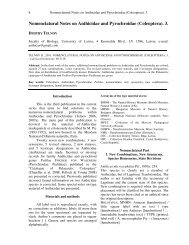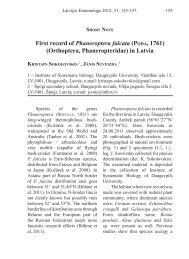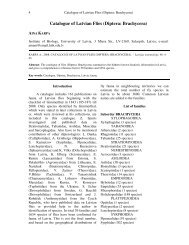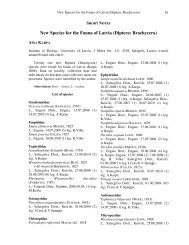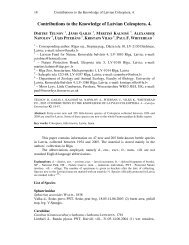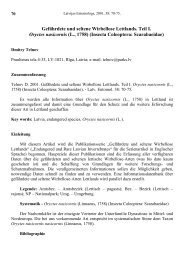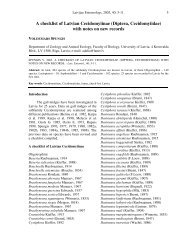Soil Mesostigmata Mites (Acari, Parasitiformes) from Hungary. II
Soil Mesostigmata Mites (Acari, Parasitiformes) from Hungary. II
Soil Mesostigmata Mites (Acari, Parasitiformes) from Hungary. II
You also want an ePaper? Increase the reach of your titles
YUMPU automatically turns print PDFs into web optimized ePapers that Google loves.
14<br />
<strong>Soil</strong> <strong>Mesostigmata</strong> <strong>Mites</strong> (<strong>Acari</strong>, <strong>Parasitiformes</strong>) <strong>from</strong> <strong>Hungary</strong>. <strong>II</strong><br />
<strong>Soil</strong> <strong>Mesostigmata</strong> <strong>Mites</strong> (<strong>Acari</strong>, <strong>Parasitiformes</strong>) <strong>from</strong> <strong>Hungary</strong>. <strong>II</strong><br />
INETA SALMANE 1 , JEN KONTSCHÁN 2<br />
1 – Corresponding author: Institute of Biology, University of Latvia, Miera iela 3, LV-2169<br />
Salaspils, Latvia; e-mail: incis@email.lubi.edu.lv<br />
2 – Systematic Zoology Research Group of the Hungarian Academy of Sciences, Department of<br />
Zoology of Hungarian Natural History Museum, Baross utca 13. H-1088 Budapest, <strong>Hungary</strong>; email:<br />
kontscha@zoo.zoo.nhmus.hu<br />
SALMANE I., KONTSCHÁN J. 2005. SOIL MESOSTIGMATA MITES (ACARI, PARASITIFORMES) FROM<br />
HUNGARY. <strong>II</strong>. – Latvijas entomologs, 43: 14-17.<br />
Abstract. <strong>Mesostigmata</strong> mites collected <strong>from</strong> various habitats in 17 localities of <strong>Hungary</strong> were investigated. In total 44<br />
<strong>Mesostigmata</strong> species were recorded. Fifteen of them were new to the fauna of <strong>Hungary</strong>.<br />
Key words: <strong>Acari</strong>, <strong>Mesostigmata</strong>, fauna, <strong>Hungary</strong>.<br />
Introduction<br />
Data on investigations of <strong>Mesostigmata</strong><br />
mite fauna in <strong>Hungary</strong> were noted in our<br />
previous work (Salmane, Kontschán 2005), and<br />
also by J. Wisniewski and W. Hirschmann<br />
(1995) and J. Wisniewski (1996). Recently one<br />
more publication was made by J. Kontschán<br />
(2005).<br />
Material and Methods<br />
Sampling was performed <strong>from</strong> diverse<br />
habitats in <strong>Hungary</strong> by J. Kontschán<br />
(Systematic Zoology Research Group of the<br />
Hungarian Academy of Sciences). Samples<br />
were extracted on Berlese-Tullgren type<br />
funnels. Identified <strong>Mesostigmata</strong> material is<br />
deposited in the Institute of Biology, University<br />
of Latvia, in the collection of I. Salmane.<br />
Species determination was made using the keys<br />
of C. Błaszak (1974), N. Bregetova (1977), K.<br />
Hyatt (1980), W. Karg (1993) and G. Shcherbak<br />
(1980).<br />
List of sampling localities<br />
Location of <strong>Mesostigmata</strong> sampling sites in<br />
<strong>Hungary</strong> is given in figure 1.<br />
Transdanubian Mts, county Veszprém<br />
L.1. 10.09.2003. Köveskál, litter.<br />
L.2. 10.09.2003. Balatonalmádi, soil and litter.<br />
L.4. 10.09.2003. Gyulafirátot, moss.<br />
L.6. 10.09.2003. Tihany, litter.<br />
L.8. 10.09.2003. Vászoly, litter.<br />
L.14. 10.09.2003. Vászoly, moss.<br />
Transdanubian Mts, county Komárom-<br />
Esztergom<br />
L.11. 17.05.2004. Szárlinget, oak forest, litter.<br />
L.13. 06.05.2004. Tata, Angol park, litter.<br />
L.15. 10.03.2004. Vargesztes, oak forest, litter.<br />
L.16. 19.03.2004. Oroszlány, Majk, alder forest,<br />
litter.<br />
Transdanubian Mts, county Fejér<br />
L.5. 10.09.2003. Bodajk, moss and litter.<br />
South-Transdanubian, county Tolna<br />
L.3. 25.04.2003. Bátaapáti, Nagy Morágyi<br />
Völgy, Lasius sp. nest.<br />
L.7. 25.04.2003. Bátaapáti, Nagy Morágyi<br />
Völgy, litter.<br />
L.9. 25.04.2003. Bátaapáti, Medvehagymas,<br />
litter.<br />
L.10. 25.04.2003. Bátaapáti, decomposing tree.<br />
L.12. 25.04.2004. Bátapáti, Nagy Morágyi<br />
Völgy, litter.<br />
L.17. 25.04.2003. Bátaapáti, Nagy Morágyi<br />
Völgy, mixed-litter.
Latvijas entomologs 2006, 43: 14-17. 15<br />
Figure 1. Location of the sampling sites of <strong>Mesostigmata</strong> mites in <strong>Hungary</strong>.<br />
Results and discussion<br />
Abbreviations used in the text: * - new<br />
species to the fauna of <strong>Hungary</strong>; L – localitties<br />
coresponding to the listed sampling localities.<br />
List of the species<br />
Gamasina LEACH, 1815<br />
Parasitidae OUDEMANS, 1901<br />
1. Parasitus kraepelini BERLESE, 1903<br />
L: 3, 9, 11, 12, 17; distribution – Europe, West-<br />
Russia<br />
2. *Parasitus crassitarsis (HALBERT, 1923)<br />
L: 9; distribution – Europe, West-Russia<br />
3. Pergamassus crassipes (LINNAEUS, 1758)<br />
L: 1, 4, 6, 13, 14, 17; distribution – Holarctic.<br />
4. Pergamasus lapponicus TRÄGARDH, 1910<br />
L: 3, 17; distribution – Palaearctic.<br />
5. Pergamasus mirabilis WILLMANN, 1951<br />
L: 3; distribution – Palaearctic.<br />
6. Pergamasus misellus BERLESE, 1904<br />
L: 3; distribution – Europe.<br />
7. Pergamasus septentrionalis (OUDEMANS,<br />
1902)<br />
L: 4, 9; distribution – Palaearctic.<br />
8. *Pergamasus suecicus (TRÄGARDH, 1936)<br />
L: 4.; distribution – Europe.<br />
9. Holoparasitus excipuliger (BERLESE, 1905)<br />
L: 4, 5, 11, 16; distribution – Europe.<br />
Veigaiaidae OUDEMANS, 1939<br />
10. Veigaia nemorensis (C.L.KOCH, 1839)<br />
L: 3, 4, 5, 8, 9, 11, 12, 16, 17; distribution –<br />
Palaearctic.<br />
11. *Veigaia cervus (KRÄMER, 1876)<br />
L: 2, 12, 17; distribution – Holarctic.<br />
Ameroseiidae (BERLESE, 1919) EVANS, 1961<br />
12. *Ameroseius corniculus KARG, 1971<br />
L: 4; distribution – West-Europe, Caucasus.<br />
13. Epicriopsis horridus (KRÄMER, 1876)<br />
L: 3; distribution – Europe.<br />
Aceosejidae BAKER, WHARTON, 1952 (sensu<br />
EVANS, 1958)<br />
14. Leioseius minusculus (BERLESE, 1905)<br />
L: 4, 15; distribution – Europe.<br />
15. Leioseius bicolor (BERLESE, 1918)<br />
L: 6, 7; distribution – Europe.<br />
16. *Cheiroseius unguiculatus BERLESE, 1887<br />
L: 16; distribution – Europe.<br />
Phytoseiidae BERLESE, 1916<br />
17. Typhlodromus cotoneastri WAINSTEIN, 1961<br />
L: 6; distribution – East-Europe.<br />
18. Amblyseius obtusus (C.L.KOCH, 1839)
16<br />
<strong>Soil</strong> <strong>Mesostigmata</strong> <strong>Mites</strong> (<strong>Acari</strong>, <strong>Parasitiformes</strong>) <strong>from</strong> <strong>Hungary</strong>. <strong>II</strong><br />
L: 1, 2, 4, 6, 8; distribution – Palaearctic,<br />
America.<br />
19. *Amblyseius graminis CHANT, 1956<br />
L: 8; distribution – Holarctic.<br />
20. *Amblyseius herbarius (WAINSTEIN, 1960)<br />
L: 14; distribution – Europe, South-Russia.<br />
Rhodacaridae OUDEMANS, 1902<br />
21. Dendrolaelaps trapezoides HIRSCHMANN,<br />
1960<br />
L: 15; distribution – Europe.<br />
22. *Asca aphidioides (LINNAEUS, 1758)<br />
L: 2, 5, 14, 15; distribution – Europe, Nearctic.<br />
23. Euryparasitus emarginatus (C.L.KOCH,<br />
1839)<br />
L: 10; distribution – Europe.<br />
24. Cyrtolaelaps mucronatus G. et<br />
R.CANESTRINI, 1881<br />
L: 10; distribution – Palaearctic.<br />
Macrochelidae VITZTHUM, 1930<br />
25. Macrocheles montanus WILLMANN, 1951<br />
L: 7; distribution – Europe.<br />
26. Macrocheles peniciliger (BERLESE, 1904)<br />
L: 9, 16; distribution – Europe.<br />
27. *Macrocheles superbus HULL, 1918<br />
L: 9; distribution – Great Britain, Kuril Islands.<br />
28. *Macrocheles muscaedomesticae (SCOPOLI,<br />
1772)<br />
L: 9; distribution – Palaearctic, America.<br />
29. Macrocheles sp.<br />
L: 17.<br />
Pachylaelaptidae VITZTHUM, 1931<br />
30. Pachylaelaps (Pachylaelaps) pectinifer (G.<br />
et R. CANESTRINI, 1882)<br />
L: 4; distribution – Europe, East-Russia.<br />
31. Pachyseius humeralis BERLESE, 1910<br />
L: 10, 12, 17; distribution – Europe, West-<br />
Russia.<br />
Laelaptidae BERLESE, 1892<br />
32. Hypoaspis (Geolaelaps) aculeifer<br />
(CANESTRINI, 1883)<br />
L: 1, 11; distribution – Holarctic, Neotropical.<br />
33. Hypoaspis (Geolaelaps) praesternalis<br />
WILLMANN, 1949<br />
L: 16; distribution – Palaearctic, Afrotropical.<br />
34. Hypoaspis (Cosmolaelaps) vacua<br />
(MICHAEL, 1891)<br />
L: 2, 4, 14; distribution – Holarctic,<br />
Afrotropical, Neotropical.<br />
35. *Hypoaspis lusisi LAPINA, 1976<br />
L: 2, 4, 8; distribution – Europe.<br />
36. Ololaelaps placentula (BERLESE, 1887)<br />
L: 16; distribution – Europe, West-Siberia.<br />
Eviphidae BERLESE, 1913<br />
37. Eviphis ostrinus (C.L.KOCH, 1836)<br />
L: 9; distribution – Palaearctic.<br />
Zerconidae CANESTRINI, 1891<br />
38. Prozercon kochi SELLNICK, 1943<br />
L: 4, 5, 9; distribution – Europe.<br />
39. *Prozercon trägardhi (HALBERT, 1923)<br />
L: 2, 11, 12, 14; distribution – Europe, West-<br />
Russia.<br />
40. *Parazercon sarekensis WILLMANN, 1939<br />
L: 2; distribution – Palaearctic.<br />
41. Zercon spatulatus C.L.KOCH, 1839<br />
L: 4, 5, 7, 9; distribution – Europe.<br />
42. *Zercon peltatus peltatus (C.L. KOCH,<br />
1836)<br />
L: 2, 4, 5, 9, 11, 14, 16, 17; distribution –<br />
Europe.<br />
43. *Zercon hungaricus SELLNICK, 1958<br />
L: 11, 12; distribution – Europe.<br />
Sejina KRÄMER, 1885<br />
Sejidae BERLESE, 1895<br />
44. Sejus togatus C.L.KOCH, 1836<br />
L: 3, 10, 17; distribution – Europe, West-Russia.<br />
A total of 44 <strong>Mesostigmata</strong> species in 12<br />
families were collected <strong>from</strong> litter, moss and<br />
other habitats of <strong>Hungary</strong>. Fifteen species were<br />
recorded for the first time in the fauna of<br />
<strong>Hungary</strong>.<br />
There were representatives of the<br />
European (19 species), European-Russian (8<br />
species) and Palaearctic (7 species) region fauna<br />
(Bregetova 1977; Karg 1993). Parasitidae with<br />
10 species was the richest <strong>Mesostigmata</strong> family.<br />
The most abundant species were Zercon<br />
hungaricus (<strong>from</strong> litter) and Zercon peltatus<br />
peltatus (<strong>from</strong> mosses and litter).<br />
Summarizing previously published data<br />
of I. Salmane and J. Kontschán (2005) and data<br />
presented in the current paper, sampling of<br />
mites has been performed in 33 localities of<br />
<strong>Hungary</strong>. Seventy four <strong>Mesostigmata</strong> species<br />
were recorded during those investigations. Fifty<br />
six of them were new to the fauna of <strong>Hungary</strong>.<br />
European species dominate in the Hungarian<br />
fauna, but also Palearctic and European-Russian<br />
species are represented. The families richest in<br />
species were Parasitidae, Zerconidae and<br />
Laelaptidae.
Kopsavilkums<br />
Rakst sniegts 17 daž d s Ung rijas<br />
viet s un atš ir gos biotopos iev kto<br />
<strong>Mesostigmata</strong> r u sugu saraksts, k ar<br />
atz m tas sugu atradnes kart . Kopum<br />
noteiktas 44 <strong>Mesostigmata</strong> r u sugas, no kur m<br />
15 ir jaunas Ung rijas faunai.<br />
References<br />
Bregetova N.G. ( . .) 1977.<br />
[Identification key for soil inhabiting<br />
mites. <strong>Mesostigmata</strong>.] Nauka, Leningrad,<br />
717 pp. (in Russian).<br />
Blaszak C. 1974. Zerconidae (<strong>Acari</strong>,<br />
Messotigmata) Polski. Panstwowe<br />
Wydawnictwo Naukowe, Warszawa,<br />
Krakow, 315 pp.<br />
Hyatt K.H. 1980. <strong>Mites</strong> of the subfamily<br />
Parasitinae (<strong>Mesostigmata</strong>: Parasitidae) in<br />
the British Isles. – Bulletin of the British<br />
Museum (Natural History), Zoology<br />
Series 38, 5: 344-347.<br />
Karg W. 1993. <strong>Acari</strong> (<strong>Acari</strong>na), Milben<br />
<strong>Parasitiformes</strong> (Anactinochaeta) Cohors<br />
Gamasina Leach. Raubmilben. Jena,<br />
Stuttgart, New York Gustav Fischer<br />
Verlag, 524 pp.<br />
Kontschán J. 2005. Contribution to the<br />
Macrochelidae fauna of <strong>Hungary</strong> (<strong>Acari</strong>:<br />
<strong>Mesostigmata</strong>). – Folia historico naturalia<br />
Musei Matraensis 29: 77-80.<br />
Salmane I., Kontschán J. 2005. <strong>Soil</strong> Gamasina<br />
mites (<strong>Acari</strong>, <strong>Parasitiformes</strong>,<br />
<strong>Mesostigmata</strong>) <strong>from</strong> <strong>Hungary</strong>. I. – Latv.<br />
Entomol., 42: 39-44.<br />
Shcherbak G. I. 1980. The family Rhodacaridae<br />
in the Palaearctic. Kiev, Naukova Dumka,<br />
215 pp. (in Russian, English abstract).<br />
Wisniewski J. 1996. The Uropodina fauna<br />
(<strong>Acari</strong>na) <strong>from</strong> the Bükk National park (N<br />
<strong>Hungary</strong>). The Fauna of the Bükk<br />
National Park: 485-486.<br />
Wisniewski J., Hirschmann W. 1995. Drei neue<br />
Oplitis-Arten (<strong>Acari</strong>na, Uropodina) aus<br />
Ungarn und Indien. – Folia Entomologica<br />
Hungarica 56: 215-222.<br />
Received: March 21. 2005.<br />
Latvijas entomologs 2006, 43: 14-17. 17


